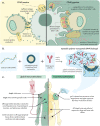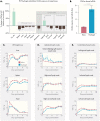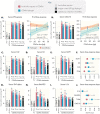Injectable Nanoparticle-Based Hydrogels Enable the Safe and Effective Deployment of Immunostimulatory CD40 Agonist Antibodies
- PMID: 35975424
- PMCID: PMC9534946
- DOI: 10.1002/advs.202103677
Injectable Nanoparticle-Based Hydrogels Enable the Safe and Effective Deployment of Immunostimulatory CD40 Agonist Antibodies
Abstract
When properly deployed, the immune system can eliminate deadly pathogens, eradicate metastatic cancers, and provide long-lasting protection from diverse diseases. Unfortunately, realizing these remarkable capabilities is inherently risky as disruption to immune homeostasis can elicit dangerous complications or autoimmune disorders. While current research is continuously expanding the arsenal of potent immunotherapeutics, there is a technological gap when it comes to controlling when, where, and how long these drugs act on the body. Here, this study explored the ability of a slow-releasing injectable hydrogel depot to reduce dose-limiting toxicities of immunostimulatory CD40 agonist (CD40a) while maintaining its potent anticancer efficacy. A previously described polymer-nanoparticle (PNP) hydrogel system is leveraged that exhibits shear-thinning and yield-stress properties that are hypothesized to improve locoregional delivery of CD40a immunotherapy. Using positron emission tomography, it is demonstrated that prolonged hydrogel-based delivery redistributes CD40a exposure to the tumor and the tumor draining lymph node (TdLN), thereby reducing weight loss, hepatotoxicity, and cytokine storm associated with standard treatment. Moreover, CD40a-loaded hydrogels mediate improved local cytokine induction in the TdLN and improve treatment efficacy in the B16F10 melanoma model. PNP hydrogels, therefore, represent a facile, drug-agnostic method to ameliorate immune-related adverse effects and explore locoregional delivery of immunostimulatory drugs.
Keywords: biomaterials; cancer; drug delivery; immunotherapy; pharmacokinetics.
© 2022 The Authors. Advanced Science published by Wiley-VCH GmbH.
Conflict of interest statement
The authors declare no conflict of interest.
Figures










Similar articles
-
Induction of potent anti-tumor responses while eliminating systemic side effects via liposome-anchored combinatorial immunotherapy.Biomaterials. 2011 Aug;32(22):5134-47. doi: 10.1016/j.biomaterials.2011.03.067. Epub 2011 Apr 22. Biomaterials. 2011. PMID: 21514665 Free PMC article.
-
Subcutaneous delivery of an antibody against SARS-CoV-2 from a supramolecular hydrogel depot.Biomater Sci. 2023 Mar 14;11(6):2065-2079. doi: 10.1039/d2bm00819j. Biomater Sci. 2023. PMID: 36723072 Free PMC article.
-
Subcutaneous delivery of an antibody against SARS-CoV-2 from a supramolecular hydrogel depot.bioRxiv [Preprint]. 2022 May 25:2022.05.24.493347. doi: 10.1101/2022.05.24.493347. bioRxiv. 2022. Update in: Biomater Sci. 2023 Mar 14;11(6):2065-2079. doi: 10.1039/d2bm00819j. PMID: 35665002 Free PMC article. Updated. Preprint.
-
Designing Hydrogels for On-Demand Therapy.Acc Chem Res. 2017 Apr 18;50(4):669-679. doi: 10.1021/acs.accounts.6b00536. Epub 2017 Mar 16. Acc Chem Res. 2017. PMID: 28301139 Free PMC article. Review.
-
Injectable Hydrogels as Local Depots at Tumor Sites for Antitumor Immunotherapy and Immune-Based Combination Therapy.Macromol Biosci. 2021 Jun;21(6):e2100039. doi: 10.1002/mabi.202100039. Epub 2021 Apr 5. Macromol Biosci. 2021. PMID: 33818918 Review.
Cited by
-
Research progress on hydrogel-based drug therapy in melanoma immunotherapy.BMB Rep. 2024 Feb;57(2):71-78. doi: 10.5483/BMBRep.2023-0160. BMB Rep. 2024. PMID: 38053295 Free PMC article. Review.
-
Enhanced safety and efficacy profile of CD40 antibody upon encapsulation in pHe-triggered membrane-adhesive nanoliposomes.Nanomedicine (Lond). 2025 Jan;20(2):155-166. doi: 10.1080/17435889.2024.2446008. Epub 2024 Dec 29. Nanomedicine (Lond). 2025. PMID: 39764733
-
Machine learning-based identification of an immunotherapy-related signature to enhance outcomes and immunotherapy responses in melanoma.Front Immunol. 2024 Sep 17;15:1451103. doi: 10.3389/fimmu.2024.1451103. eCollection 2024. Front Immunol. 2024. PMID: 39355255 Free PMC article.
-
Hydrogel drug delivery systems for minimally invasive local immunotherapy of cancer.Adv Drug Deliv Rev. 2023 Nov;202:115083. doi: 10.1016/j.addr.2023.115083. Epub 2023 Sep 9. Adv Drug Deliv Rev. 2023. PMID: 37673217 Free PMC article. Review.
-
Generation of an inflammatory niche in a hydrogel depot through recruitment of key immune cells improves efficacy of mRNA vaccines.Sci Adv. 2025 Apr 11;11(15):eadr2631. doi: 10.1126/sciadv.adr2631. Epub 2025 Apr 11. Sci Adv. 2025. PMID: 40215318 Free PMC article.
References
-
- a) Rosenberg S. A., Sci. Transl. Med. 2012, 4, 127ps8; - PMC - PubMed
- b) Alexander W., P T 2016, 41, 185; - PMC - PubMed
- c) Topalian S. L., Hodi F. S., Brahmer J. R., Gettinger S. N., Smith D. C., McDermott D. F., Powderly J. D., Carvajal R. D., Sosman J. A., Atkins M. B., N. Engl. J. Med. 2012, 366, 2443; - PMC - PubMed
- d) Larkin J., Chiarion‐Sileni V., Gonzalez R., Grob J. J., Cowey C. L., Lao C. D., Schadendorf D., Dummer R., Smylie M., Rutkowski P., N. Engl. J. Med. 2015, 373, 23. - PMC - PubMed
-
- a) Binnewies M., Roberts E. W., Kersten K., Chan V., Fearon D. F., Merad M., Coussens L. M., Gabrilovich D. I., Ostrand‐Rosenberg S., Hedrick C. C., Vonderheide R. H., Pittet M. J., Jain R. K., Zou W., Howcroft T. K., Woodhouse E. C., Weinberg R. A., Krummel M. F., Nat. Med. 2018, 24, 541; - PMC - PubMed
- b) Bonaventura P., Shekarian T., Alcazer V., Valladeau‐Guilemond J., Valsesia‐Wittmann S., Amigorena S., Caux C., Depil S., Front. Immunol. 2019, 10, 10. - PMC - PubMed
-
- Zou W., Nat. Rev. Cancer 2005, 5, 263. - PubMed
Publication types
MeSH terms
Substances
Grants and funding
LinkOut - more resources
Full Text Sources
Medical
Research Materials
Miscellaneous
